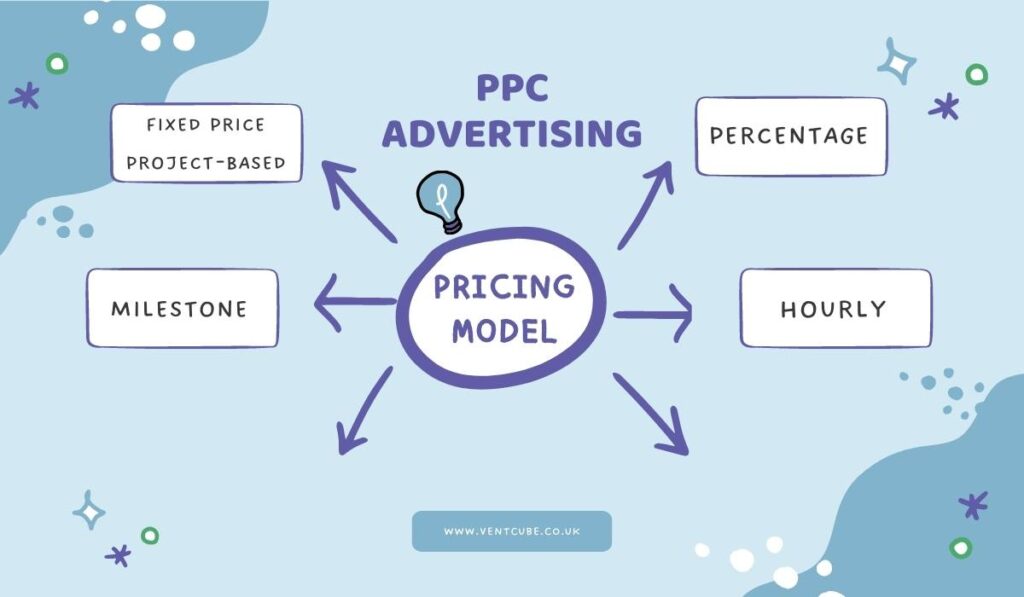Navigating the digital marketing landscape can often feel like trying to solve a complex puzzle, especially when it comes to understanding PPC pricing models. To be successful in your online advertising endeavours, you need to grasp these models because they ultimately determine how much you’ll pay for your advertising and how much you can expect in return. This guide is designed to demystify PPC pricing models and provide a clearer picture of each offer’s advantages and drawbacks. Whether you’re an established brand or a start-up, understanding these models can help create an effective marketing strategy aligned with your budget and goals.
The Four Main PPC Pricing Models
Understanding the four principal pricing models is crucial for businesses, marketing managers, and entrepreneurs looking to navigate the intricacies of PPC advertising. These models include
-
The Fixed Price/Project Based Pricing Model,
-
Performance by Milestone Pricing Model,
-
Hourly Pricing Model, and
-
Percentage of Ad Spend Price Model.
As a rule of thumb, these models are typically employed by advertisers to shape and drive their marketing campaigns in alignment with their business goals and budget constraints. Let’s deep dive into each PPC pricing model to understand them better:
Fixed Price/Project-Based Pricing Model
The Fixed Price or Project Based Pricing model is arguably the simplest among PPC pricing models. As the name suggests, this model entails a fixed monthly fee, not concerning the amount of time the PPC agency puts into the work. This model is akin to a retainer, where the agency provides a vast range of services towards a larger goal. The benefit of this model lies in its simplicity and predictability. However, it’s not suitable for everyone. The fixed-price model might involve a setup fee and a long-term contract, which may not be feasible for a PPC strategy for small businesses or those with a tight budget.
Performance by Milestone Pricing Model
The Performance by Milestone Pricing Model aligns the agency’s fee with certain predefined milestones or goals. This could be leads acquired, increased click-through rate, conversion rates, or revenue growth. In theory, this model encourages the agency to work harder for their fee, focusing on tangible results. However, the flip side to this model is the potential for agencies to pad metrics by including unqualified leads, which might not grow your business. Therefore, clear communication and transparency are crucial in this model.
Hourly Pricing Model
In the Hourly Pricing Model, the agency charges for every hour of work provided. This model offers budgeting ease and flexibility to change the work scope swiftly if needed. However, it can also lead to inefficiencies, as agencies might extend work hours without necessarily providing more value. Clients need to be proactive in monitoring the agency’s performance to get the most out of this model.
Percentage of Ad Spend Price Model
The Percentage of Ad Spend Pricing Model bases the agency’s fee on your total ad spend, usually around 10-20%. This model makes sense for businesses investing heavily in PPC marketing as the more you spend, the more work the agency does, and correspondingly, the more they charge. This model provides great transparency, making it suitable for businesses of all sizes. However, some agencies might suggest increasing your PPC budget to boost their fee, underscoring the need for vigilance and questioning unusual budget increases.
Comparing Pricing Models across Platforms
The four principal PPC pricing models – Fixed Price/Project Based Pricing Model, Performance by Milestone Pricing Model, Hourly Pricing Model, and Percentage of Ad Spend Price Model, each come with their own set of advantages and drawbacks. They cater to varying business needs and budget considerations. In order to better understand these models, we’ll dive into a comparative analysis supported by industry data.
Fixed Price/Project-Based Pricing Model vs. Performance by Milestone Pricing Model
The Fixed Price model offers a predictable cost structure, making it easier for companies to budget their marketing expenditure. However, industry data shows this model might be costlier, given that the agency guarantees a range of services for a flat rate. On the other hand, the Performance by Milestone model ties costs directly to results. It provides motivation for agencies to achieve more. Nevertheless, companies must ensure they’re not being charged for low-quality leads.
Hourly Pricing Model vs. Percentage of Ad Spend Price Model
The Hourly Pricing model is straightforward – you pay for the time the agency spends on your project. Businesses with fluctuating needs prefer this model as it gives the flexibility to scale up or down depending on the requirements. However, the downside is potential inefficiency, as the agency has no direct incentive to deliver results faster. In comparison, the Percentage of Ad Spend model directly correlates with the agency’s fee and the client’s advertising budget. As the ad spend increases, so does the agency’s fee. Businesses often prefer this model for its scalability and transparency, although it necessitates vigilant monitoring to ensure that an increase in spending correlates to performance improvement.
Fixed Price/Project-Based Pricing Model vs. Hourly Pricing Model
While both models have predictability in terms of cost, the Fixed Price model is more beneficial for businesses with well-defined, long-term goals. In contrast, the Hourly Pricing model is ideal for businesses with variable needs or those on a tight budget.
Performance by Milestone PPC Pricing Models vs. Percentage of Ad Spend Price Model
Both models are performance-oriented, but they have different approaches. Performance by Milestone focuses on specific results, whereas the Percentage of Ad Spend model revolves around the overall advertising budget.
The Role and Strategy of Budgeting in PPC
Budgeting is an indeposable part of a successful Pay-Per-Click (PPC) campaign. It ensures that you are investing wisely, getting the most out of your investment. Understanding the role of budgeting in PPC and strategizing can improve the overall performance of your campaigns.
The Role of Budgeting in PPC
Setting Financial Boundaries: Budgeting provides a financial framework for your PPC campaign. It defines how much you’re willing to invest in your campaign and helps you avoid overspending.
Optimizing Campaign Performance: By allocating your budget to different keywords, ad groups, and campaigns based on their performance, you can optimize your PPC efforts. Budgeting allows you to invest more in high-performing campaigns and less in those that aren’t delivering expected results.
Maximizing ROI: Proper budgeting can improve your return on investment. You can increase your returns by focusing on profitable keywords and campaigns and adjusting your bids and budget allocation based on performance.
Budgeting Strategies for PPC Pricing Models
Setting a Campaign Budget: Start by establishing a total budget for your PPC campaign. Considering your overall marketing budget and expected return on investment, this should be a sum you’re comfortable spending.
Keyword and Bid Management: Allocate your budget based on keyword performance. Invest more in keywords that generate leads and conversions and less in low-performing ones. Also, use bid management strategies to optimize your keyword bids.
Budget Distribution: Distribute your budget across different campaigns based on their performance. High-performing campaigns should get a larger share of the budget.
Performance Analysis and Adjustment: Regularly analyze your campaign performance. Adjust your budget allocation based on changing trends and performance metrics.
Seasonal Adjustments: Certain times of the year, like holidays or sales seasons, may see higher competition and increased costs. Adjust your budget to accommodate these fluctuations.
Test and Refine: Experiment with different budgeting strategies, analyze their outcomes, and refine your approach based on the results.
Remember, budgeting in PPC isn’t a one-time task. It’s a continuous analysis, adjustment, and optimization process to ensure that you’re investing your money wisely and getting the highest possible returns.
Estimating PPC Campaign Costs with Different PPC Pricing Models
Estimating the costs of a PPC campaign can seem daunting, but with the precise tools and understanding of the latest pricing models – Fixed Price/Project Based, Performance by Milestone, Hourly, and Percentage of Ad Spend – it becomes significantly easier. Various online resources provide detailed insights and estimates based on diverse parameters such as keywords, competition level, and geographic location, helping you align your marketing budget efficiently.
For instance, in a Fixed Price/Project Based model, the costs are pre-determined and constant, making budgeting simpler. In contrast, the Performance by Milestone model will require a more dynamic budget, fluctuating based on the goals achieved. Similarly, the Hourly model needs constant monitoring to ensure that the work hours align with the campaign’s progression, while the Percentage of Ad Spend model requires a careful analysis of the total ad expenditure.
Choosing the Right PPC Pricing Model for Your Business
Selecting the ideal PPC Pricing Model requires a meticulous evaluation of various critical factors. You need to consider your specific business objectives, the budget you have set aside for advertising, the demographics and types of behaviour of your target audience, and the type of your product or service.
A Fixed Price/Project Based model might suit you if your campaign goals are long-term and consistent and you prefer a predictable budget. On the other hand, a Performance by Milestone model could be the perfect fit if you’re goal-oriented and prefer to pay for tangible results. If you require flexibility and are willing to monitor the agency’s progress closely, an Hourly model would be ideal. Conversely, the Percentage of Ad Spend model would be the most suitable if you’re looking for transparency and a cost that scales with your advertising spend.
The key lies in understanding the potential of each pricing model and leveraging it to align with your broader business goals and marketing strategies. This approach ensures a balanced advertising budget and increases your return on investment, leading to a successful and effective PPC campaign.
Measuring ROI in PPC Advertising
Ultimately, the result shows the efficacy of a tool or strategy. No matter how well you’ve understood the PPC Pricing Models and devised your strategy, the real litmus test is the ROI your campaigns generate. Regularly Measuring ROI in PPC Advertising provides invaluable insights into your campaign’s success and indicates areas of improvement. You can refine and optimize your PPC campaigns to increase conversions and minimize costs by tracking key performance metrics and understanding how they translate into ROI.
Conclusion
Gaining a deep understanding of the various PPC pricing models, namely Fixed Price/Project Based, Performance by Milestone, Hourly, and Percentage of Ad Spend, is a pivotal part of developing a robust digital marketing strategy. Your choice between these pricing models should be aligned with your specific marketing objectives, target audience, budget limitations, and the nature of your campaign.
Understanding how each model operates will enable you to make informed decisions and leverage the strengths of each one. Whether it’s the simplicity and predictability of the Fixed Price model, the incentive-driven nature of the Performance by Milestone model, the flexibility of the Hourly model, or the transparency of the Percentage of Ad Spend model, each has unique features that can serve your campaigns well when used strategically.
Looking for expert PPC management to boost your online advertising? Look no further! VentCube Digital Marketing Agency London specializes in driving results through strategic PPC campaigns. Our team of seasoned professionals will optimize your budget, increase conversions, and maximize your ROI. Contact us today to take your business to new heights!



